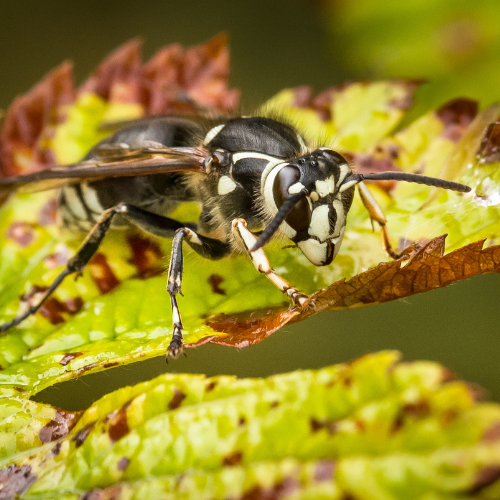Bald-faced Hornets
Introduction to
Bald-faced hornets are aggressive stinging insects known for their large, aerial nests and distinctive black and white coloring. While they play a role in controlling pest populations, their presence near human habitation can pose significant risks. This guide provides detailed information on how to recognize, understand, and manage bald-faced hornets, including preventive measures and professional pest control solutions.
Recognition
Bald-faced hornets (Dolichovespula maculata) are large, black and white wasps measuring about 1/2 to 3/4 inch in length. They have a distinctive black body with white markings on their face, thorax, and the end of their abdomen. Their wings are transparent and their bodies are robust and smooth. Unlike true hornets, bald-faced hornets are more closely related to yellowjackets but can be distinguished by their unique color pattern and slightly larger size.
Biology
Bald-faced hornets belong to the family Vespidae and are social insects that live in large colonies. A typical colony starts in the spring with a single queen, who lays eggs and raises the first generation of workers. These workers then take over foraging and caring for subsequent broods. Colonies can grow to contain several hundred individuals by the end of the summer. Bald-faced hornets build large, spherical paper nests, usually in trees or shrubs, but sometimes attached to buildings. The nests are made from chewed wood fibers mixed with saliva and can reach the size of a basketball or larger.
Habits
Bald-faced hornets are highly territorial and aggressive, especially when defending their nest. They will sting repeatedly and can inject venom that causes significant pain and swelling. Unlike bees, hornets do not die after stinging and can attack multiple times. Bald-faced hornets are primarily carnivorous, feeding on other insects such as flies, caterpillars, and spiders. They also consume nectar and fruit juices. Hornets are most active during the day and return to their nests at night. The nests are typically abandoned in the fall, and the queen overwinters to start a new colony the following spring.
Prevention
Preventing bald-faced hornet infestations involves making your property less attractive to these insects and taking proactive measures to avoid encounters. Regularly inspect your property for early signs of nest-building in the spring and remove small nests before they can grow. Keep outdoor trash bins tightly sealed and clean up food and drink spills promptly, as these can attract hornets. Maintain a clean and tidy yard, trimming back shrubs and trees where nests are likely to be built. If you spot a nest, do not attempt to remove it yourself, as disturbing the nest can provoke aggressive behavior. Instead, contact a professional pest control service to handle the situation safely.
Professional
When bald-faced hornets become a persistent problem, professional pest control services can offer effective solutions. STL Pest Control provides comprehensive inspections and tailored treatment plans to address bald-faced hornet infestations. Their methods include safely removing nests, using insecticides when necessary, and implementing preventive measures to deter future nesting. Professional services ensure that the infestation is managed efficiently and safely, minimizing the risk to humans and pets while respecting the important ecological role that hornets play in controlling pest populations.



Our Office









